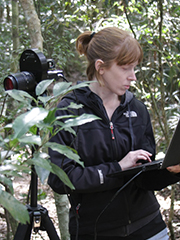Dr. Cynthia Tedore

Research Associate
Behavioural Biology
Address
Office
Contact
CV
Academic CV
| 2018-present | Research Associate, Behavioral Biology, University of Hamburg (Prof. Jutta Schneider), Germany |
| 2017-2018 | Postdoc, Centre d’Ecologie Fontionnelle & Evolutive du Centre National de la Recherche Scientifique (Dr. Julien Renoult & Dr. François Molino), France |
| 2013-2017 | Postdoc, Lund Vision Group, Lund University (Prof. Dan-Eric Nilsson), Sweden |
| 2013 | PhD, Biology, Duke University (Prof. Sönke Johnsen), NSF GRFP Fellow & James B. Duke Fellow, USA |
Research interests
My research program investigates the evolution of animal visual systems and perceptual biases, and how they evolve in response to the visual properties of an animal’s environment and lifestyle. I also study what drives and/or constrains the evolution of colors and patterns in all sorts of natural objects, from spiders, birds, fruits, and flowers to the dominant components of terrestrial habitat structure -- foliage and leaf litter. My research group is currently using and developing a variety of approaches and methodologies, including multispectral imaging, spectroscopy, spatial pattern analyses, behavioral assays, ophthalmoscopy, and simulations of animal perception using artificial intelligence.
Publications
Tedore C (2024). A comparison of photographic and spectrometric methods to quantify the colours seen by animal eyes. Methods in Ecology and Evolution 15, 4-23.
Hardenbicker MC and Tedore C (2023). Peacock spiders prefer image statistics of average natural scenes over those of male ornamentation. Behavioral Ecology 34, 719–728.
Tedore C, Tedore K, Westcott, D, Suttner C, & Nilsson D-E (2022). The role of detectability in the evolution of avian-dispersed fruit color. Vision Research, 196, 108046
Glenszczyk M*, Outomuro D*, Gregorič M, Kralj-Fišer S, Schneider JM, Nilsson DE, Morehouse NI, Tedore C (2022). The jumping spider Saitis barbipes lacks a red photoreceptor to see its own sexually dimorphic red coloration. The Science of Nature 109:6. *co-first authors
Arias M, Leroy L, Madec C, Matos L, Tedore C, Elias M, Gomez D (2021). Partial wing transparency works better when disrupting wing edges: evidence from a field experiment. Journal of Evolutionary Biology, 34, 1840-1846.
Arias M*, Tedore C*, Elias M, Leroy L, Madec L, Matos C, Renoult JP, Gomez D (2020). Deep neural network and field experiments reveal how transparent wing windows reduce detectability in moths. bioRxiv doi.org/10.1101/2020.11.27.401497. *co-first authors
Tedore C and Nilsson D-E (2021). Ultraviolet vision aids the detection of nutrient-dense non-signaling plant foods. Vision Research 183, 16-29, https://authors.elsevier.com/sd/article/S0042-6989(21)00027-4
Tedore C and Nilsson D-E (2019). Avian UV vision enhances leaf surface contrasts in forest environments. Nature Communications 10, 238.
Chouinard-Thuly L, Gierszewski S, Rosenthal G, Reader S, Rieucau G, Woo K, Gerlai R, Tedore C, Ingley S, Witte K (2017). Technical and conceptual considerations for using animated stimuli in studies of animal behavior. Current Zoology 63, 5-19.
Tedore C and Johnsen S (2017). Using RGB displays to portray color realistic imagery to animal eyes. Current Zoology 63, 27-34.
Tedore C and Johnsen S (2016). Disentangling the visual cues used by a jumping spider to locate its microhabitat. The Journal of Experimental Biology 219, 2396-2401.
Tedore C and Johnsen S (2015). Immunological dependence of plant-dwelling animals on the medicinal properties of their plant substrates: A preliminary test of a novel evolutionary hypothesis. Arthropod-Plant Interactions 9, 437-446.
Tedore C and Johnsen S (2015). Visual mutual assessment of size in male Lyssomanes viridis jumping spider contests. Behavioral Ecology 26, 510-518.
Tedore C and Johnsen S (2013). Pheromones exert top-down effects on visual recognition in the jumping spider Lyssomanes viridis. The Journal of Experimental Biology, 216, 1744-1756.
Tedore C and Johnsen S (2012). Weaponry, color, and contest success in the jumping spider Lyssomanes viridis. Behavioural Processes 89, 203-211.
